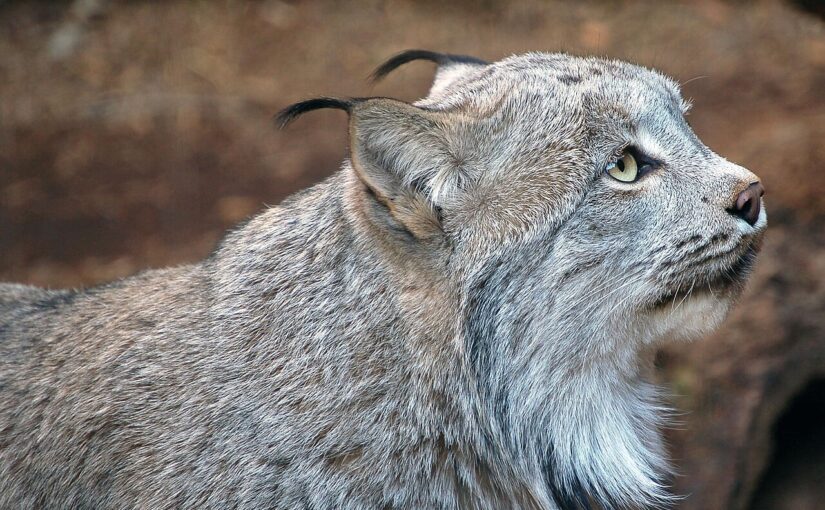In the snowy wilds of North America lives a cat so perfectly built for its world that to see it is to witness winter itself in motion. The Canadian lynx, Lynx canadensis, haunts the forests of Canada, Alaska, and the northern United States with quiet grace and haunting yellow eyes. Smaller and slightly lighter than its Eurasian cousin, the Canadian lynx thrives in landscapes where cold reigns and the snow lies thick for much of the year.
At first glance, the Canadian lynx might seem like a little cousin to the grand old-world lynxes of Europe and Russia. With an average body weight around eleven kilograms and a typical length from nose to tail of eighty to a hundred and five centimeters, it presents a compact silhouette. Stand one beside a domestic cat, however, and the lynx’s imposing beauty and wildness are clear. Males are noticeably larger than females, lumbering across the snows with longer legs in back than in front, giving the animal a slightly humped posture and a spring-loaded stride.
The fur of the Canadian lynx is thick, plush, and ranges in color from a soft yellow-brown to shimmery gray. The animal bristles with character: from the heavy, broad chin to the signature tufts of black hair on the tips of its ears. Perhaps the most charming feature of all is the paws. Oversized and deeply furred, these act like natural snowshoes and allow the lynx to pad across the surface of deep powder with an ease that would make any human skier jealous.
Much of the Canadian lynx’s territory is covered in boreal forest, a realm of silent spruce, whispering birch, and hidden muskegs. Here, beneath the hush of falling snow and the shadow of frosty trees, the lynx follows the fortunes of its lifeline and favorite meal: the snowshoe hare. The fate of this feline is as intertwined with this rabbit as perhaps any two animals in nature. The snowshoe hare feeds, the lynx follows; the hare population rises, and so too do lynx numbers; the hare population plummets, and the wild cats swiftly dwindle.
This dynamic cycle of predator and prey repeats roughly every ten years and has fascinated generations of biologists. Sometimes snowshoe hare numbers explode, brushing the forest floor with swift feet and filling the undergrowth with their presence. The following years see an upsurge in the lynx population, feasting on this abundance and raising more kittens than usual. Inevitably, as hounds in the poetic chase, lynxes exhaust their food source. The hares dwindle, and lynx numbers drop in their wake. This elusive dance, a living graph of ecology, is one of nature’s enduring wonders and a classic example in biology textbooks.
The Canadian lynx is mainly a creature of the night. With large, glowing eyes and senses primed for stealth, it slips through the forest at dusk and dawn, stalking prey. Though solitary by nature, except for mothers with kittens, these cats can cover huge territories in their quest for food, sometimes ranging over fifty square kilometers. Their silence and ability to blend into the snowy world around them make sightings a rare treat even for those who live nearby.
Despite their focus on snowshoe hares, these lynxes are adaptable enough to take birds, mice, and squirrels if opportunity arises. But the snowshoe hare, with its own seasonal camouflage and rapid reproductive rate, remains the heartbeat of the lynx’s existence. Winters when hares are scarce are hard years for lynx mothers and their young.
Geographically, the Canadian lynx claims Canada and Alaska as its heartland, but its range extends into the northern United States, creeping down into states like Idaho, Montana, Oregon, and Washington, especially where boreal forests stretch south along the mountains. In southern reaches, its territory may overlap with the bobcat, another master of survival, but the lynx is unmistakable for its longer legs, tufted ears, shorter tail, and stubbier face. Even its track in fresh snow, round and broad, tells the savvy observer that this is no ordinary cat.
The lifecycle of a lynx mirrors the rhythms of its landscape. After solitary winters, males and females come together in late winter or early spring to mate. The female gives birth, usually in a secluded den among thickets or fallen logs, to a litter of kittens that will learn, through play and practice, the subtle art of hunting in a silent white world.
While the Canadian lynx is not currently threatened across much of its range, changes in climate and landscape can tip the balance. Boreal forests are under ever-increasing pressure from development and warming temperatures, which may in turn affect the environment suited for both hare and lynx. Awareness, careful management, and continued protection will keep the silent paw prints of this remarkable cat quietly weaving through the snows for generations to come.
In the end, the Canadian lynx remains a symbol of wild winter: a creature that comes alive in the twilight, whose story is written in snow, and whose leap across the drifts is the purest celebration of nature’s resilience in the frozen north.
If you find joy in these tales of twitching whiskers and gleaming eyes, consider helping keep Whiskerito.com alive and purring. Your donation supports thoughtful research, engaging content, and the warm, wonder-filled community that makes this space what it is.
